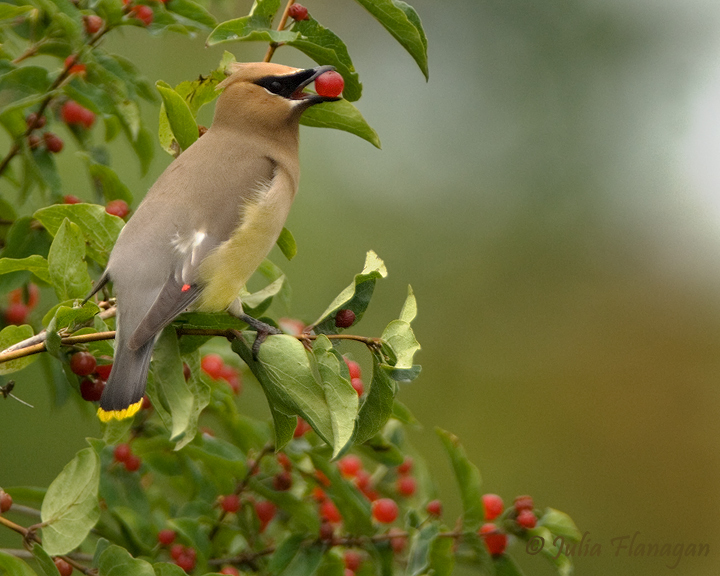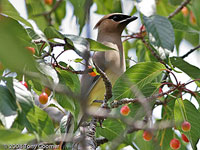
|
Cedar Waxwing The Cedar Waxwing is an elegantly handsome bird with unique markings. Overall a pale cinnamon brown fading to gray on the wings and tail, it has a black mask, outlined in white, surrounding its eyes, a pointed crest (which may be erect or lie lax) on its head, a yellowish belly and bright yellow-tipped short tail feathers. The second part of its name refers to the bright red waxy tips on the secondary wing feathers, sometimes creating a sort of stripe near the ends of the wings. Some of the gray parts may even have a pale bluish tinge, adding to its array of colors, like a part costume. The "Cedar" part of its name apparently comes from its preference for berries and fruit, such as the dark "berries" of the red cedar (Juniperus virginiana). Their nesting season is, in fact, delayed until later than most birds, to a part of the summer when more fruit is available. During the breeding period the parent birds will collect a number of berries in their crops to regurgitate and feed to their young on the nest. Outside of the breeding season, Cedar Waxwings travel and feed in flocks, sometimes passing berries from bird to bird along a branch! Among the plants that could attract Cedar Waxwings to your neighborhood are dogwood, serviceberry, juniper, hawthorn, winterberry, mulberry, cherry, privet, yew, hackberry, choke cherry, and crab apple. The Waxwing lives in open wooded areas and along forest edges from rural towns into cities. Their range extends from the northern US from coast to coast to southern and central Canada up to the tree line in summer, but they retreat in winter to the southern part of the range the US as well as Mexico, Central America and the Caribbean. This bird is a year-round resident of rhe Appalachians and the Mid-Atlantic states including Virginia. When not breeding, Cedar Waxwings may form large noisy flocks that grow, shrink, divide, and rejoin in flight like flocks of Starlings. Their nests are loose open cups of grass, twigs and other plant material built on tree branches. Both parents build the nest and feed the young; the female sits on about a half-dozen eggs at a time. They tend to nest in groups. When not breeding, Cedar Waxwings may form large noisy flocks that grow, shrink, divide, and rejoin in flight like flocks of Starlings. |
Home | Upcoming Events | About Us | Resource Issues | News | Local Contacts Maps | Photos | Publications | Youth Education | FAQ's | Links | Membership |






